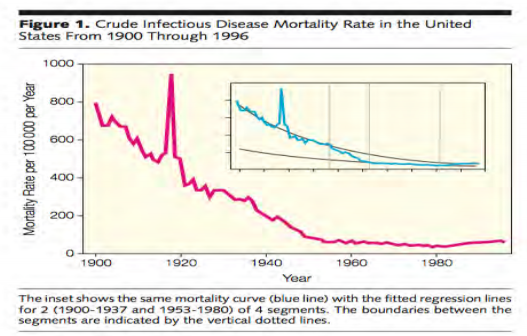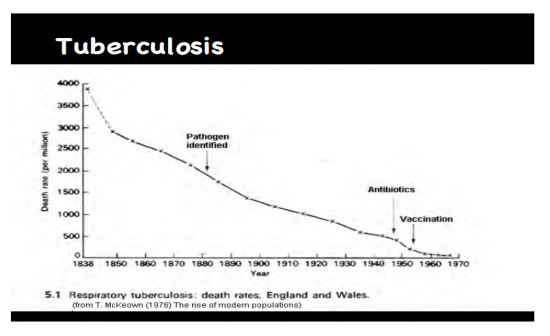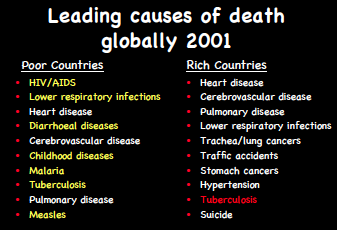Cards In This Set
| Front | Back |
|
Disease definition
|
A harmful deviation from the normal structural or functional state of an organism
|
|
What is the difference between infectious and non-infectious disease?
|
Infectious disease moves from person to person to person - it's communicable (or animal to animal or plant to plant). non-infectious disease does not move from host to host. Transmission is a formal term and understanding how a disease is transmitted is crucial to its management
|
|
Disease vs. pathogen
|
Diseases and pathogens are similar, but not the same. Pathogens cause disease in the appropriate environment. ex. pneumonia is a general description for severe lung congestion, a disease and may be caused by a number of bacteria or viruses (pathogens)
|
|
Disease triangle
|
Disease is hte result of several factors coming together in a dynamic system. Can be simplified to 3 basic components: host, pathogen and environment. With one component missing, no idsease. Can also be used to manage disease
|
|
History of life expectancy
|
People died very young. For example, in the 17th century there were gravestones of people 17 and 20 years old. in 6000 BC in Turkey the mean (50% dead) life expectancy was 20-25. This was the same life expectancy for london in 1728 and in 1830 it increased a bit, but not by much. in 1861 the mean life expectancy was early 50's (70% still living at age 20). In the U.S. in 1985 the mean life expectancy was much higher and at age 20 almost 100% of people were still living
|
|
Major causes of death in the U.S. 1900
|
Tuberculosis, pneumonia, diarrhea 30%. Diptheria, bronchitis, 5%. Heart disease, cancer, stroke, 16%. Injuries 5%.
|
|
Major causes of death in the U.S. in 2000
|
Heart Disease, cancer, stroke 62% (increased from 16% in 1900). Injuries 4%. TB, flu, pneumonia, diarrhea 4%. Diptheria, bronchitis not significant
|
|
Major childhood disease history
|
Diptheria, pertissis, measles and polio rates all bottomed out by 2000. Diptheria was very high in 1900 and then dropped quickly to nothing by 2000.
|
|
Infectious disease mortality rate in the united states from 1900 through 1996 - and why this curve?
|
 Dropped drastically with a peak around 1920. Why the differences in mortality?: vaccines, antibiotics, antiseptics, drugs, clean water (sewage treatment), "cleaner" food - pasteurization, refrigeration. research and education, pesticides |
|
Tuberculosis rate graph
|
 |
|
Triumph over disease
|
1962: Australian Nobel laureate said that mid 20th century had seen "the virtual elimination of the infectious disease as a significant factor in social life
1967: U.S. Surgeon General announced "time to close the books on infectious disease and shift all national efforts to chronic diseases 1990s: Resurgence of infectious diseases |
|
Emerging and Re-emerging diseases
|
Emerging diseases: new diseases (like AIDs emergence)
Re-emerging diseases: Diseases that were once a problem, receded, but are making a comeback (like tuberculosis in Russia) |
|
Tuberculosis in Russia
|
Although mortality stayed relatively stable, morbidity spiked after the collapse of the Soviet Union in the 90s because access to healthcare was more difficult and jails are overloaded. also a resistant strain of tuberculosis was selected for. Tuberculosis was a re-emerging disease
|
|
Microbial evolution and adaptation
|
1. Living things evolve and develop offensive mechanisms (pathogens have virulence - relative ability of a microorganism to cause disease)
2. Microbes evolve quickly (in a matter of hours) and reproduce rapidly (can change with each generation) 3. They adapt to antibiotics. For example: tuberculosis bacteria have become resistant to antibiotics |
|
Infectious disease in poor and rich countries
|
 In much of the world infectious disease never decreased. in 2001 7/10 leading causes of death in poor countries were infectious diseases, whereas in rich countries only 1/10 (tuberculosis) |



